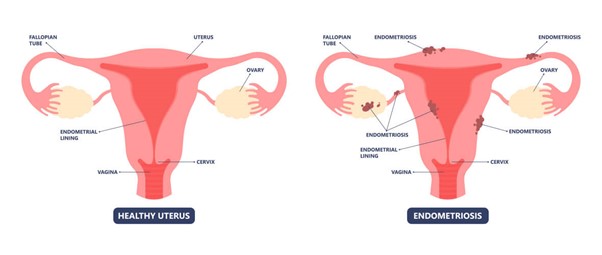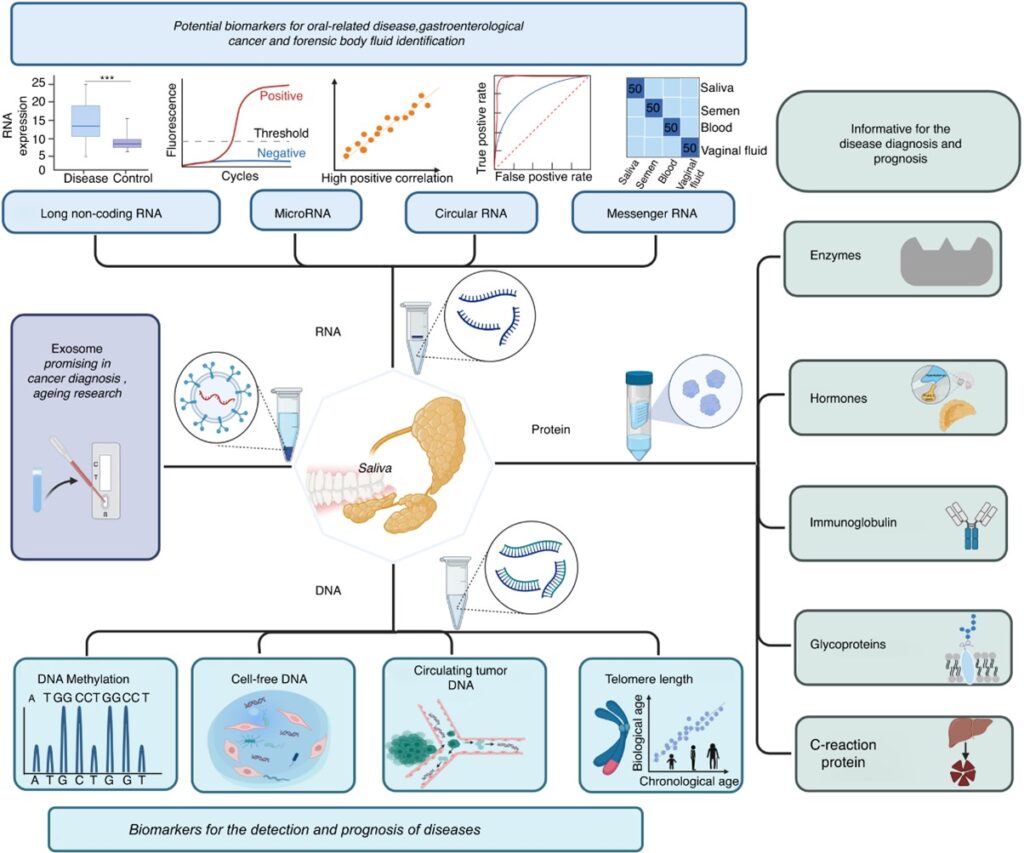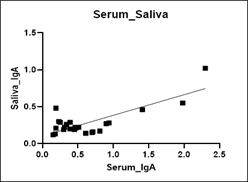In early June 2023, a study published in the NEJM Evidence demonstrated validation of a salivary miRNA signature used for the early detection of endometriosis. Endometriosis is histologically defined by the presence of endometrium-like tissue outside the uterus, with the growth of this tissue leading to chronic inflammation and scarring. The disease, often misdiagnosed or dismissed as menstrual cramps affects up to 10% of the female childbearing population worldwide and in addition to chronic pain, can drastically reduce fertility. There is no known available cure for endometriosis, with current clinical strategy focused on managing symptoms. Early diagnosis is critical to slowing down disease progression.

Figure 1. Endometriosis. From: https://americanpregnancy.org/womens-health/endometriosis/
Screening for endometriosis is challenging. Clinical guidelines published in 2022 recommend consideration of a multitude of often non-specific symptoms, resulting in costly, invasive examinations. Studies have shown that these examinations have limited diagnostic value, making overall diagnosis especially challenging.
A 109 miRNA signature was developed through next-generation sequencing and AI, when applied to a single-centre prospective study of women with endometriosis. The current study expanded on these initial findings, applying external validation of this gene signature collected from saliva samples. The diagnostic signature obtained a sensitivity of 96.2% and a specificity of 95.1%. Interim data suggests that this test may replace invasive laparoscopy when performed after imaging and provides a key example of how non-invasive salivary samples may be applied to biomarker analysis.
Saliva is highly accessible, and as a result, is extremely attractive as a matrix of choice for biomarker studies. Saliva-based analytes have shown diagnostic value in oral disease, diabetes, renal diseases, hepatitis, neurodegenerative disease and immunodeficiency disease. Critically, this utility relies on a good correlation between biomarker levels in saliva and blood.
Whole saliva is a mixture containing saliva, epithelial cells, microorganisms and food debris. The most prominent organic components include enzymes, hormones, cytokines, immunoglobulins, mucins and lactoferrins. Promising saliva biomarkers include:
DNA biomarkers
- DNA methylation
- Telomere length
- Cell free DNA
- Circulating tumor DNA (particularly for oral cancers)
*Proper control and references are necessary to distinguish bacterial from human DNA in saliva.
RNA
- mRNA
- miRNA
Protein and hormone biomarkers
- Enzymes: Various diseases, including cardiovascular diseases, Alzheimer’s disease, oral disease and cancers, can be diagnosed by studying salivary enzymatic markers, the most prominent of which are salivary amylases
- Secretory IgA (sIgA): sIgA is the most prominent antibody in saliva and is the first line of defence against bacteria and viruses like SARS-CoV-2. For example, sIgA, detected in saliva, was predictive of lung infection status in cystic fibrosis patients
- Hormones: Cortisol is secreted by adrenal glands and has been applied as a diagnostic biomarker in various diseases, however, it fluctuates with circadian rhythm and needs to be collected at very specific time points
- Exosomal biomarkers
- Salivary exosome biomarkers are less abundant than their blood counterparts and therefore require significant enrichment during isolation. Despite this, salivary exosomal biomarkers have been applied as exploratory biomarkers in cancer, neurodegenerative disease and wound healing

Figure 2. Utility of salivary biomarkers. From Song, M et al. Int J Oral Sci 15, 2 (2023).
Taken together, saliva presents a minimally invasive matrix, with a significant pool of available biomarkers. Each biomarker is different and assays quantifying salivary biomarkers will need to carefully address assay sensitivity and robustness. Salivary biomarkers can also have significant utility in diagnosis, particularly for challenging and underdiagnosed diseases like endometriosis.
In our over 20 years of clinical experience, Synexa has worked with a very diverse range of clinical sample matrices including serum plasma, stool, saliva, dried blood spots, CSF, tissue biopsies and blister fluid. In 2020, we had the opportunity to study salivary immunoglobulins specific to SARS-CoV-2 antigens and performed correlation analyses between serum and saliva matrices collected from infected and healthy donors.

Figure 3. Correlations between saliva and serum IgA against SARS-CoV-2 spike. R2 = 0.599, p < 0001. Unpublished in-house data.
If you would like to learn more about how Synexa can support your biomarker needs from a diversity of matrix types, get in touch with us at contactus@synexagroup.com.
Blog written by Dr. Nicholas Woudberg
References:
- https://americanpregnancy.org/womens-health/endometriosis/
- Bendifallah et al. NEJM Evid 2023;2(7) (2023)
- https://www.who.int/news-room/fact-sheets/detail/endometriosis#:~:text=Endometriosis%20is%20a%20disease%
20in,period%20and%20last%20until%20menopause - Song, M et al. Int J Oral Sci 15, 2 (2023).



